2020高考英语阅读理解解题技巧专项突破五:阅读理解专题之观点态度题(含答案)
2020高考英语阅读理解解题技巧专项突破五:阅读理解专题之观点态度题(含答案)
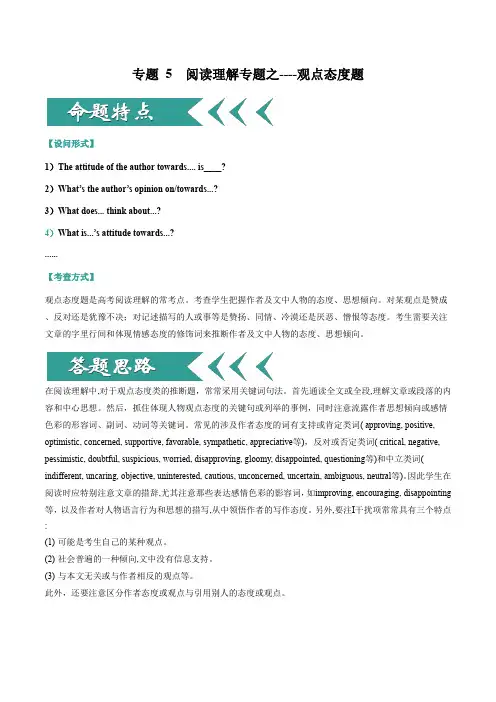
专题 5 阅读理解专题之----观点态度题【设问形式】1)The attitude of the author towards.... is____?2)What’s the author’s opinion on/towards...?3)What does... think about...?4)What is...’s attitude towards...?......【考查方式】观点态度题是高考阅读理解的常考点。
考查学生把握作者及文中人物的态度、思想倾向。
对某观点是赞成、反对还是犹豫不决;对记述描写的人或事等是赞扬、同情、冷漠还是厌恶、憎恨等态度。
考生需要关注文章的字里行间和体现情感态度的修饰词来推断作者及文中人物的态度、思想倾向。
在阅读理解中,对于观点态度类的推断题,常常采用关键词句法。
首先通读全文或全段,理解文章或段落的内容和中心思想。
然后,抓住体现人物观点态度的关键句或列举的事例,同时注意流露作者思想倾向或感情色彩的形容词、副词、动词等关键词。
常见的涉及作者态度的词有支持或肯定类词( approving, positive, optimistic, concerned, supportive, favorable, sympathetic, appreciative等),反对或否定类词( critical, negative, pessimistic, doubtful, suspicious, worried, disapproving, gloomy, disappointed, questioning等)和中立类词( indifferent, uncaring, objective, uninterested, cautious, unconcerned, uncertain, ambiguous, neutral等)。
因此学生在阅读时应特别注意文章的措辞,尤其注意那些表达感情色彩的影容词,如improving, encouraging, disappointing 等,以及作者对人物语言行为和思想的措写,从中领悟作者的写作态度。
高考英语阅读理解解题技巧专项突破五:阅读理解专题之观点态度题
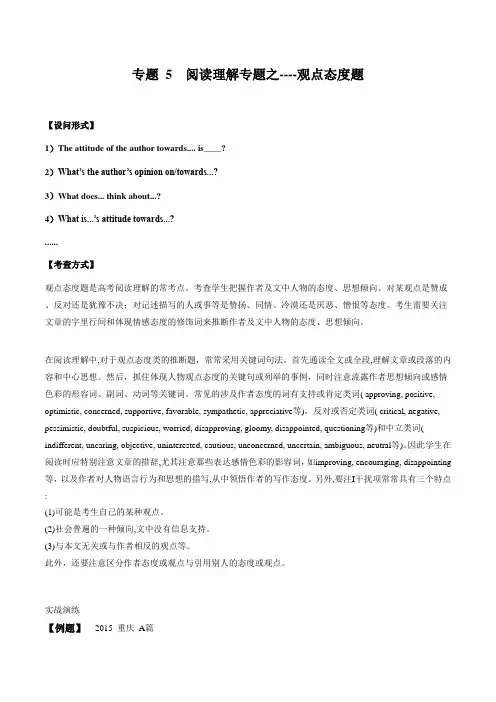
专题 5 阅读理解专题之----观点态度题【设问形式】1)The attitude of the author towards.... is____?2)What’s the author’s opinion on/towards...?3)What does... think about...?4)What is...’s attitude towards...?......【考查方式】观点态度题是高考阅读理解的常考点。
考查学生把握作者及文中人物的态度、思想倾向。
对某观点是赞成、反对还是犹豫不决;对记述描写的人或事等是赞扬、同情、冷漠还是厌恶、憎恨等态度。
考生需要关注文章的字里行间和体现情感态度的修饰词来推断作者及文中人物的态度、思想倾向。
在阅读理解中,对于观点态度类的推断题,常常采用关键词句法。
首先通读全文或全段,理解文章或段落的内容和中心思想。
然后,抓住体现人物观点态度的关键句或列举的事例,同时注意流露作者思想倾向或感情色彩的形容词、副词、动词等关键词。
常见的涉及作者态度的词有支持或肯定类词( approving, positive, optimistic, concerned, supportive, favorable, sympathetic, appreciative等),反对或否定类词( critical, negative, pessimistic, doubtful, suspicious, worried, disapproving, gloomy, disappointed, questioning等)和中立类词( indifferent, uncaring, objective, uninterested, cautious, unconcerned, uncertain, ambiguous, neutral等)。
因此学生在阅读时应特别注意文章的措辞,尤其注意那些表达感情色彩的影容词,如improving, encouraging, disappointing 等,以及作者对人物语言行为和思想的措写,从中领悟作者的写作态度。
高考英语阅读理解之观点态度题习题讲义
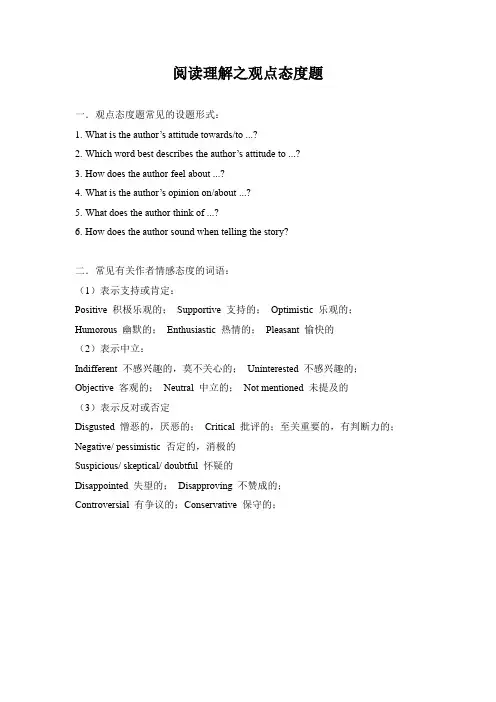
阅读理解之观点态度题一.观点态度题常见的设题形式:1.What is the author’s attitude towards/to ...?2.Which word best describes the author’s attitude to ...?3.How does the author feel about ...?4.What is the author’s opinion on/about ...?5.What does the author think of ...?6.How does the author sound when telling the story?二.常见有关作者情感态度的词语:(1)表示支持或肯定:Positive 积极乐观的;Supportive 支持的;Optimistic 乐观的;Humorous 幽默的;Enthusiastic 热情的;Pleasant 愉快的(2)表示中立:Indifferent 不感兴趣的,莫不关心的;Uninterested 不感兴趣的;Objective 客观的;Neutral 中立的;Not mentioned 未提及的(3)表示反对或否定Disgusted 憎恶的,厌恶的;Critical 批评的;至关重要的,有判断力的;Negative/ pessimistic 否定的,消极的Suspicious/ skeptical/ doubtful 怀疑的Disappointed 失望的;Disapproving 不赞成的;Controversial 有争议的;Conservative 保守的;态度题练习If messages must happen outside of the set communication hours, such as for urgent or time-sensitive issues, make employees phone or text only. This way people can comfortably close down all other communication channels like email, WeChat, WeCom, etc. The act of having to call or text someone is usually enough to give the sender a pause to think, "Do I really need this person now, or can the communication wait?" This allows everyone on your team to work whenever is appropriate for them, but not feel like they have to work all the time to accommodate everyone else's schedule. A word of "Thanks for being so responsive" to someone answering an email outside of the defined communication hours definitely brings empathy(同理心), which smooths the urgency while also cultivating the trust and culture.1.What is the author's attitude to the combination of "flex time" and "communication hours"?A.Neutral. B.Supportive. C.Opposed. D.Indifferent.I see people trapped in a pathological (病态的) relationship with time-sucking technology, where they serve technology more than technology serves them. I call this technology servitude. I am referring to a loss of personal freedom and independence because of uncontrolled consumption of many kinds of devices that eat up time and money.2. What’s the author’s attitude towards the overusing of high-tech devices?A. Neutral.B. Skeptical.C. Disapproving.D. Sympathetic.The shed craze makes that outcome more likely. A white-collar worker who has tried to work from the kitchen table for the past nine months might be keen (渴望的) to return to the office. A worker who has a beautiful garden shed with Wi-Fi will be less so. Joel Bird, who builds personalized sheds, is certain that his customers foresee a long-term change in their working habits. “They don’t consider it to be temporary,” he says. “They’re spending too much money.”3. What is Joel Bird’s attitude to the return of post-COVID office jobs?A. Enthusiastic.B. Uncaring.C. Optimistic.D. Pessimistic.Traditionally, improvements in energy efficiency have mostly focused on individual devices, which can be quite fruitful. But focusing on individual devices is like if Apple had spent effort inventing a better alarm clock, a better CD player, a better calendar, and a better camera. Now with an iPhone, we don’t need the standalone(独立运行的) devices at all, because it can function as all of them.4. What does the author think of traditional practices in energy improvements?A. Fruitless.B. Out-of-date.C. Adequate.D. Perfect.Not surprisingly, this great action has made Mary Hardison very famous and also earned her a place in the Guinness World Records where she broke a 2007 record set by a 100-year-old British woman. What an amazing lady!5.How does the author feel about Mary’s actionA. AmazedB. SupportiveC. DoubtfulD. WorriedIn high school, I was still embarrassed and wished we were not so poor, but I loved my mom and the other members of my family and knew we had things to be proud of ...... I am proud to be who I am and proud of where I’m from.6. What is the author’s attitude to his family background?A. Careless.B. Proud.C. Annoyed.D. Disappointed.We expected that field trips wouldn’t harm test scores. However, we never predicted the all-around improvements for students who joined in these field trips, “said Erickson, a researcher in the study.” One potential reason for this is that field rips widen students’ world concepts and introduce them to new ideas. Similarly, students might be more engaged in school thanks to field trips. Students find school more exciting and want to try harder in class.7. What is Erickson’s attitude towards the result of the study?A. Doubtful.B. Negative.C. Disappointed.D. Surprised.One spring afternoon, Mrs. Blackstone asked me to stay after class. “I’d like to speak with you, Amanda.” My mind raced. Had I made a bad grade? Had I hurt someone’s feelings?8. How did the author feel when she was asked to stay behind one afternoon?A. Bored.B. Excited.C. Surprised.D. Anxious.The study authors suggest that companies who benefit from the use of these images should set aside a small percentage of their profits for protection efforts and informational campaigns. “That would be not only something fair, but something that could bring a win-win situation for them,” Courchamp says. It could bring them positive public relation, for example. Besides, if a company’s mascot (吉祥物) goes extinct, that could hurt them from a marketing point, Courchamp says. But not enough companies are “truly concerned about the protection of the species that they work on,” he adds.9. What’s Courchamp’s attitude to the companies benefiting from animal images?A. Neutral.B. Supportive.C. Positive.D. Dissatisfied.Additionally, Baker says, because so much time is spent at work, it is a good idea to consider signing up for workplace wellness programs, if offered. “Many companies want to see their employees thrive, so they will offer incentives to help them improve their health, like the My Health Rewards program we are starting at UAB,” Baker said. “Whether it is to improve your energy level, improve mood, combat health conditions and disease, or to be there for your kids, future, there’s always a reason that a resolution was made,” Baker said.10. What’s Baker’s attitude towards the My Health Rewards program?A. Negative.B. Positive.C. Unconcerned.D. Doubtful.【1题详解】推理判断题。
高考阅读理解题型-观点态度题详解及练习
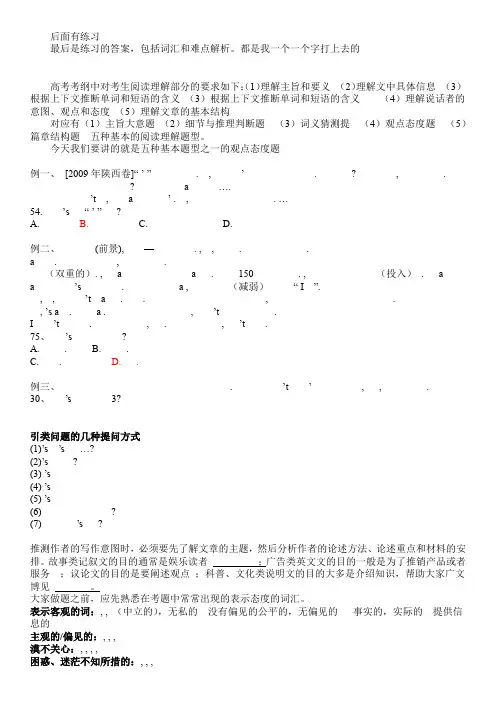
后面有练习最后是练习的答案,包括词汇和难点解析。
都是我一个一个字打上去的高考考纲中对考生阅读理解部分的要求如下:(1)理解主旨和要义(2)理解文中具体信息(3)根据上下文推断单词和短语的含义(3)根据上下文推断单词和短语的含义(4)理解说话者的意图、观点和态度(5)理解文章的基本结构对应有(1)主旨大意题(2)细节与推理判断题(3)词义猜测提(4)观点态度题(5)篇章结构题五种基本的阅读理解题型。
今天我们要讲的就是五种基本题型之一的观点态度题例一、[2009年陕西卷]“ ’ ” . , ’ . ? , .? a ….’t , a ’ . , . …54. ’s “ ’ ” ?A. B. C. D.例二、(前景), —. , , . .a . , .(双重的). , a a . 150 . , (投入). aa ’s . a , (减弱)“ I ”., , ’t a . . , ., ’s a . a . , ’t .I ’t . , . , ’t .75、’s ?A. .B. .C. .D. .例三、. ’t ’ , , .30、’s 3?引类问题的几种提问方式(1)’s ’s …?(2)’s ?(3) ’s(4) ’s(5) ’s(6) ?(7) ’s ?推测作者的写作意图时,必须要先了解文章的主题,然后分析作者的论述方法、论述重点和材料的安排。
故事类记叙文的目的通常是娱乐读者;广告类英文文的目的一般是为了推销产品或者服务;议论文的目的是要阐述观点;科普、文化类说明文的目的大多是介绍知识,帮助大家广文博见。
大家做题之前,应先熟悉在考题中常常出现的表示态度的词汇。
表示客观的词:, , (中立的),无私的没有偏见的公平的,无偏见的事实的,实际的提供信息的主观的/偏见的:, , ,漠不关心:, , , ,困惑、迷茫不知所措的:, , ,感情色彩深、程度深:, , ,程度较浅,谨慎的:, , ,积极意义的:肯定的,积极的赞成的,有利的赞成,同意支持的,支援的辩护的,保卫的乐观的自信的,确信的尊敬的赞成,承认赞成,支持幽默的清醒的消极意义的:否定的,消极的批评的(讽刺的)焦虑的,担心的悲观的忧虑的反对的怀疑的可疑的,不确定的说反话的,讽刺的不赞成反对,不赞成反对批评,批判气愤的做观点态度题时要注意:1.注意不要把我们自己的好恶态度糅进其中,不要用带有主观倾向的视角评判作者态度。
英语阅读理解中的观点态度和自由题解题方法
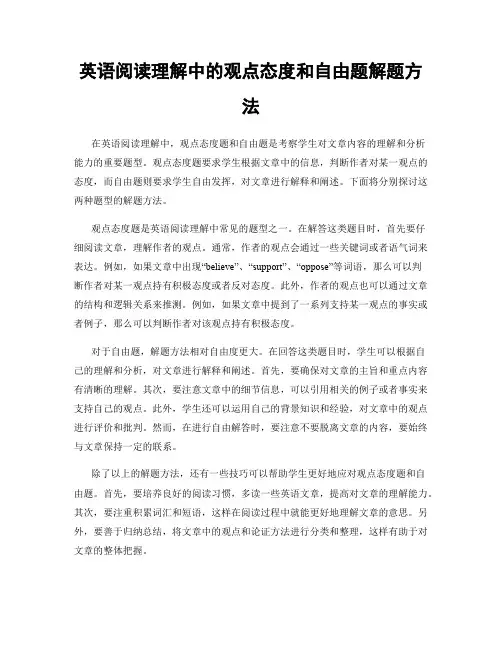
英语阅读理解中的观点态度和自由题解题方法在英语阅读理解中,观点态度题和自由题是考察学生对文章内容的理解和分析能力的重要题型。
观点态度题要求学生根据文章中的信息,判断作者对某一观点的态度,而自由题则要求学生自由发挥,对文章进行解释和阐述。
下面将分别探讨这两种题型的解题方法。
观点态度题是英语阅读理解中常见的题型之一。
在解答这类题目时,首先要仔细阅读文章,理解作者的观点。
通常,作者的观点会通过一些关键词或者语气词来表达。
例如,如果文章中出现“believe”、“support”、“oppose”等词语,那么可以判断作者对某一观点持有积极态度或者反对态度。
此外,作者的观点也可以通过文章的结构和逻辑关系来推测。
例如,如果文章中提到了一系列支持某一观点的事实或者例子,那么可以判断作者对该观点持有积极态度。
对于自由题,解题方法相对自由度更大。
在回答这类题目时,学生可以根据自己的理解和分析,对文章进行解释和阐述。
首先,要确保对文章的主旨和重点内容有清晰的理解。
其次,要注意文章中的细节信息,可以引用相关的例子或者事实来支持自己的观点。
此外,学生还可以运用自己的背景知识和经验,对文章中的观点进行评价和批判。
然而,在进行自由解答时,要注意不要脱离文章的内容,要始终与文章保持一定的联系。
除了以上的解题方法,还有一些技巧可以帮助学生更好地应对观点态度题和自由题。
首先,要培养良好的阅读习惯,多读一些英语文章,提高对文章的理解能力。
其次,要注重积累词汇和短语,这样在阅读过程中就能更好地理解文章的意思。
另外,要善于归纳总结,将文章中的观点和论证方法进行分类和整理,这样有助于对文章的整体把握。
总之,观点态度题和自由题是英语阅读理解中的重要题型,解答这类题目需要学生具备良好的阅读理解能力和分析思维能力。
通过掌握相关的解题方法和技巧,学生可以更好地应对这类题目,提高阅读理解的水平。
同时,积极阅读和多练习也是提高英语阅读理解能力的有效途径。
高考英语二轮复习阅读理解中推理判断—观点态度题考查解读
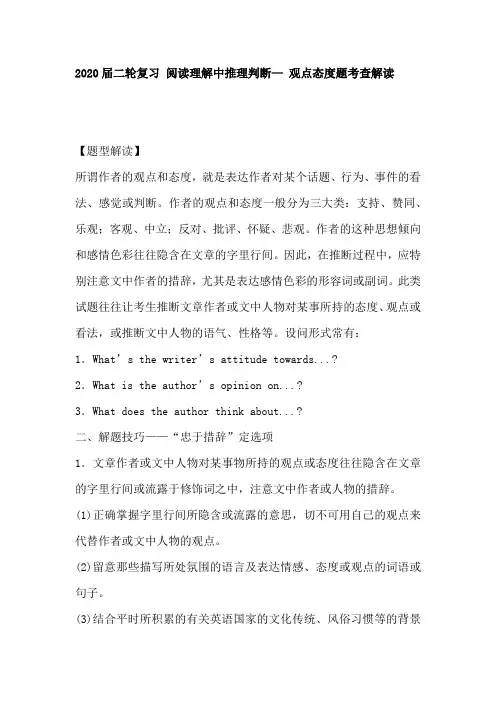
2020届二轮复习阅读理解中推理判断—观点态度题考查解读【题型解读】所谓作者的观点和态度,就是表达作者对某个话题、行为、事件的看法、感觉或判断。
作者的观点和态度一般分为三大类:支持、赞同、乐观;客观、中立;反对、批评、怀疑、悲观。
作者的这种思想倾向和感情色彩往往隐含在文章的字里行间。
因此,在推断过程中,应特别注意文中作者的措辞,尤其是表达感情色彩的形容词或副词。
此类试题往往让考生推断文章作者或文中人物对某事所持的态度、观点或看法,或推断文中人物的语气、性格等。
设问形式常有:1.What’s the writer’s attitude towards...?2.What is the author’s opinion on...?3.What does the author think about...?二、解题技巧——“忠于措辞”定选项1.文章作者或文中人物对某事物所持的观点或态度往往隐含在文章的字里行间或流露于修饰词之中,注意文中作者或人物的措辞。
(1)正确掌握字里行间所隐含或流露的意思,切不可用自己的观点来代替作者或文中人物的观点。
(2)留意那些描写所处氛围的语言及表达情感、态度或观点的词语或句子。
(3)结合平时所积累的有关英语国家的文化传统、风俗习惯等的背景知识来进行合理的推断。
(4)关注首段首尾句,推断文章主题,确定作者观点。
2.要分清选项中的表示支持或肯定、中立、反对或否定的词语,再以此对照文章内容。
下面是一些常见的有关作者情感、态度的词语:(1)表示支持或肯定的词语favorable赞同的,有利的;positive积极的,肯定的,确实的;supportive支持的;approval赞成,正式批准;reasonable合理的;enthusiastic热情的等。
(2)表示反对或否定的词语critical批评的;negative否定的,消极的;disapproval不赞成;impractical不实际的;radical激进的;prejudiced有成见的,偏颇的等。
英语阅读理解态度观点题解题方法
英语阅读理解态度观点题解题方法阅读理解是英语考试中的重要部分,其中涉及到一些关于态度观点的题目。
解答这类题目需要我们理解文章的整体意义,并准确捕捉作者的态度和观点。
下面将介绍一些解答英语阅读理解态度观点题的方法。
首先,要仔细阅读题目和文章。
在阅读之前,确保你理解了题目中要求的内容。
在阅读文章时,要注意其中的细节和关键信息,例如描述特定情境、举例或者进行比较和对比的部分。
这些信息往往能够帮助我们理解作者的观点和态度。
其次,寻找作者态度的关键句。
一篇文章往往会表达出作者对某个问题的态度,而这个态度常常会通过关键句来呈现。
关键句往往具有以下特点:使用强烈的形容词或副词,或者带有明显情感色彩的词语;通过对比、转折或者修辞手法等方式进行强调。
当我们找到这些关键句之后,就可以推断出作者的观点和态度。
另外,要注意文章的语气和情感色彩。
作者通过语气和情感色彩可以表达出自己对某种观点的支持或者否定。
例如,如果作者使用一种激进的语气,使用负面的词语来描述某个观点,那么我们可以推断作者对该观点持反对态度。
相反,如果作者使用较为温和的语气,使用积极的词语来描述某个观点,那么我们可以推断作者对该观点持支持态度。
此外,我们还可以通过对比观点和进行推理来判断作者的态度。
在一篇文章中,作者可能会提到不同的观点并进行比较,这时我们可以通过对比观点的表达和推理逻辑来判断作者对这些观点的态度。
例如,如果作者提到某个观点并进行了否定,而对另一个观点进行了肯定,我们就可以推断作者支持后者。
最后,要根据文章的整体意义来确定作者的态度。
一篇文章可能会涉及到多个观点和角度,我们不能仅通过某个关键句来确定作者的态度,而是要将文章作为一个整体来看待。
我们要注意作者在整篇文章中所传递的信息和主旨,以此来推断出作者的观点和态度。
总而言之,解答英语阅读理解态度观点题需要我们仔细阅读题目和文章,寻找作者态度的关键句,并结合文章的语气、情感色彩、对比观点和整体意义来确定作者的观点和态度。
高中英语阅读理解技巧之态度观点判断
高中英语阅读理解技巧之态度观点判断在高中英语学习中,阅读理解是一项重要的技能,而态度观点判断是其中的一部分。
正确的态度观点判断可以帮助我们更好地理解文章的主旨和作者的意图。
下面将介绍一些高中英语阅读理解中的态度观点判断技巧。
首先,要注意文章中的修辞手法和词语的用法。
作者通过使用特定的修辞手法和词语来表达自己的态度和观点。
例如,如果文章中使用了大量的形容词和副词来形容某个事物,那么作者很可能对这个事物持有积极的态度。
另外,作者使用否定词或者讽刺的语气来表达自己的反对观点。
通过仔细分析文章中的修辞手法和词语的用法,我们可以判断出作者的态度和观点。
其次,要注意文章的结构和组织方式。
作者通常会通过文章的结构和组织方式来表达自己的态度和观点。
例如,如果文章采用对比的方式来呈现两种不同的观点,那么作者可能希望读者能够理解他对其中一种观点的支持或反对。
另外,作者在文章中可能会使用一些强调的手法,例如重复某个观点或者使用大量的例子来支持自己的观点。
通过仔细分析文章的结构和组织方式,我们可以更好地理解作者的态度和观点。
此外,要注意文章中的语气和情感色彩。
作者在文章中使用的语气和情感色彩可以反映出他的态度和观点。
例如,如果文章中使用了激动或者愤怒的语气,那么作者可能对某个问题感到不满或者愤怒。
另外,作者在文章中可能会使用一些感叹词或者情感词语来表达自己的情感。
通过仔细分析文章中的语气和情感色彩,我们可以推断出作者的态度和观点。
最后,要注意文章中的逻辑关系和论证方式。
作者通常会通过逻辑关系和论证方式来表达自己的态度和观点。
例如,作者可能会通过列举事实和数据来支持自己的观点,或者通过引用权威人士的观点来增加自己观点的可信度。
另外,作者在文章中可能会使用一些转折词或者因果关系来表达自己的观点。
通过仔细分析文章中的逻辑关系和论证方式,我们可以更好地理解作者的态度和观点。
综上所述,高中英语阅读理解中的态度观点判断是一项重要的技巧。
高中阅读理解:观点态度题技巧总结及巩固训练
阅读理解:观点态度题技巧总结及巩固训练观点态度题主要是考查学生根据文章内容推断出作者对某人或某事物的观点或态度,或是文中某人或某机构对人或事物的观点或态度的能力。
一、观点态度试题的设题方式和表述观点态度的选项有哪些∶设题方式:1. Whats the author's attitude towards...?2. What is the opinion of the writer in this passage?3. Which of the following does the author agree with?三类选项:(一)支持、赞同、乐观1. positive adj.肯定的,积极的2. favorable adj.赞成的,有利的3. supportive adj支持的4. approving adj 赞成3. optimistic adj 乐观的(二)反对、批评、怀疑、悲观1. disapproving adj不赞成2. negative 否定的,消极的3. critical adj.批评的4. controversial 有争议的5. conservative adj.保守的6. suspicious adj.怀疑的7. doubtful adj.怀疑的8. pessimistic(三)中立、客观1. subjective adj.主观的1. objective adj.客观的2. netural adj.中立的5. indifferent adj 漠不关心二、总结解题技巧总结:对作者的观点态度的推理和判断必须以事实为依据,判断有据, 推论有理, 忠实原文。
切忌用自己的观点代替作者的本意。
解答观点态度题常用的解题技巧如下:①辨清文章的文体。
议论文中,主题句一般暗示作者的态度。
说明文一般为客观中立的态度。
记叙文中,观点往往不会直接提出,但作者在写作时常会有某种倾向性,所以要求考生要捕捉表达或暗示情感态度的词或短语。
新高考英语二轮复习 :专题05 阅读理解“态度推断”题 (含高考真题)解析版
态度观点态度类试题的解题方法:第一:结合题干人物和内容定位原文出现在哪一(些)段;然后仔细比对该句言外之意;第二:加入自己的态度。
要注意区分试题考查的是作者的态度还是作者引用别人的态度;第三:态度没有明确提出时,要学会根据作者在文章中所运用词汇的褒贬性去判断作者的态度,尤其是动词、形容词和副词,如wonderfully, successfully, unfortunately, doubtfully 等。
乐观支持类词汇:optimistic乐观的;positive肯定的;favorable 支持的,赞同的;supportive支持的;approving 赞成的客观中立类词汇:objective客观的;neutral中立的;cautious谨慎的消极反对类词汇:negative否定的;opposite相反的;unfair公正的;doubtful怀疑的;indifferent漠不关心的;critical 批评的;ironic讽刺的;skeptical质疑的;disappointed失望的;disapproving不赞同的;pessimistic悲观的;dismissive 轻蔑的,不屑一顾的【高考真题再练】01(2023年新高考I卷D篇)On March 7, 1907, the English statistician Francis Galton published a paper which illustrated what has come to be known as the “wisdom of crowds” effect. The experiment of estimation he conducted showed that in some cases, the average of a large number of independent estimates could be quite accurate.This effect capitalizes on the fact that when people make errors, those errors aren’t always the same. Some people will tend to overestimate, and some to underestimate. When enough of these errors are averaged together, they cancel each other out, resulting in a more accurate estimate. If people are similar and tend to make the same errors, then theirerrors won’t cancel each other out. In more technical terms, the wisdom of crowds requires that people’s estimates be independent. If for whatever reasons, people’s errors become correlated or dependent, the accuracy of the estimate will go down.But a new study led by Joaquin Navajas offered an interesting twist (转折) on this classic phenomenon. The key finding of the study was that when crowds were further divided into smaller groups that were allowed to have a discussion, the averages from these groups were more accurate than those from an equal number of independent individuals. For instance, the average obtained from the estimates of four discussion groups of five was significantly more accurate than the average obtained from 20 independent individuals.In a follow-up study with 100 university students, the researchers tried to get a better sense of what the group members actually did in their discussion. Did they tend to go with those most confident about their estimates? Did they follow those least willing to change their minds? This happened some of the time, but it wasn’t the dominant response. Most frequently, the groups reported that they “shared arguments and reasoned together.” Somehow, these arguments and reasoning resulted in a global reduction in error. Although the studies led by Navajas have limitations many questions remain the potential implications for group discussion and decision-making are enormous.32. What is paragraph 2 of the text mainly about?A. The methods of estimation.B. The underlying logic of the effect.C. The causes of people’s errors.D. The design of Galton’s experiment.33. Navajas’ study found that the average accuracy could increase even if ________.A. the crowds were relatively smallB. there were occasional underestimatesC. individuals did not communicateD. estimates were not fully independent34. What did the follow-up study focus on?A. The size of the groups.B. The dominant members.C. The discussion process.D. The individual estimates.35. What is the author’s attitude toward Navajas’ studies?A. Unclear.B. Dismissive.C. Doubtful.D. Approving.【答案】32. B 33. D 34. C 35. D【解析】【导语】本文是说明文。
- 1、下载文档前请自行甄别文档内容的完整性,平台不提供额外的编辑、内容补充、找答案等附加服务。
- 2、"仅部分预览"的文档,不可在线预览部分如存在完整性等问题,可反馈申请退款(可完整预览的文档不适用该条件!)。
- 3、如文档侵犯您的权益,请联系客服反馈,我们会尽快为您处理(人工客服工作时间:9:00-18:30)。
专题 5 阅读理解专题之----观点态度题【设问形式】1)The attitude of the author towards.... is____?2)What’s the author’s opinion on/towards...?3)What does... think about...?4)What is...’s attitude towards...?......【考查方式】观点态度题是高考阅读理解的常考点。
考查学生把握作者及文中人物的态度、思想倾向。
对某观点是赞成、反对还是犹豫不决;对记述描写的人或事等是赞扬、同情、冷漠还是厌恶、憎恨等态度。
考生需要关注文章的字里行间和体现情感态度的修饰词来推断作者及文中人物的态度、思想倾向。
在阅读理解中,对于观点态度类的推断题,常常采用关键词句法。
首先通读全文或全段,理解文章或段落的内容和中心思想。
然后,抓住体现人物观点态度的关键句或列举的事例,同时注意流露作者思想倾向或感情色彩的形容词、副词、动词等关键词。
常见的涉及作者态度的词有支持或肯定类词( approving, positive, optimistic, concerned, supportive, favorable, sympathetic, appreciative等),反对或否定类词( critical, negative, pessimistic, doubtful, suspicious, worried, disapproving, gloomy, disappointed, questioning等)和中立类词( indifferent, uncaring, objective, uninterested, cautious, unconcerned, uncertain, ambiguous, neutral等)。
因此学生在阅读时应特别注意文章的措辞,尤其注意那些表达感情色彩的影容词,如improving, encouraging, disappointing 等,以及作者对人物语言行为和思想的措写,从中领悟作者的写作态度。
另外,要注I干扰项常常具有三个特点:(1)可能是考生自己的某种观点。
(2)社会普遍的一种倾向,文中没有信息支持。
(3)与本文无关或与作者相反的观点等。
此外,还要注意区分作者态度或观点与引用别人的态度或观点。
实战演练【例题】2015 重庆A篇At thirteen, I was diagnosed(诊所) with a kind of attention disorder. It made school difficult for me. When everyone else in the class was focusing on tasks, I could not.In my first literature class, Mrs. Smith asked us to read a story and then write on it, all within 45 minutes. I raised my hand right away and said,“Mrs. Smith, you see, the doctor said I have attention problems. I might not be able to do it.”She glanced down at me through her glasses, “You are no different from your classmates, young man.”I t ried, but I didn’t finish the reading when the bell rang. I had to take it home.In the quietness of my bedroom, the story suddenly all became clear to me. It was about a blind person, Louis Braille. He lived in a time when the blind couldn’t get much education. But Louis didn’t give up. Instead, he invented a reading system of raised dots(点), which opened up a whole new world of knowledge to the blind.Wasn’t I the “blind” in my class, being made to learn like the “sighted” students? My thoughts spilled ou t and my pen started to dance. I completed the task within 40 minutes. Indeed, I was no different from others; I just needed a quieter place. If Louis could find his way out of his problems, why should I ever give up?I didn’t expect anything when I handed in my paper to Mrs. Smith, so it was quite a surprise when it came back to me the next day —with an “A” on it. At the bottom of the paper were these words: “ See what you can do when you keep trying?”38.What was Mrs.Smith’s attitude to the author at the end of the story?A.Angry.B.Impatient.C.Sympathetic.D.Encouraging.【解析】38.D 观点态度。
根据最后一段提到so it was a surprise when it came back to me the next day—with an “A”当我看到作业上A时,非常的吃惊,史密斯小姐对我的态度是令人鼓励的,故选D项。
【举一反三】AI live in the center of the city and there is a large parking lot full of parking spots nearby.Rain is a rare occurrence in LA,so cars easily collect pollutants and dust.Together with my friends,I decided it should be a kind gesture to surprise the owners with a car wash.So we bought car washing supplies and brought out all the bath towels we could find.With all the supplies in hand,we were able to convince another roommate to help outas well and we began watering down the cars.Every once in a while,someone would come by and asked us seemingly stupid men,“Who told you to wash the cars?”or,even better,“who paid you to wash their cars?”We explained we just wanted to do something kind.But our response was often me with an even more confused look.As the afternoon went on,some other friends that came by understood our goal of the spontaneous event and started helping out with some of the duties.First one friend then two,and by the time we had cleaned the entire lot,we had an entire car washing crew with independent individually assigned tasks and duties.I wasn't cleaning cars to be able to afford a new phone.I was cleaning cars simply because I wanted to offer the car owners kindness.There was no equipment to weigh our value created.We couldn’t measure our success in dollars earned over the time spent washing cars when we could have been earning twice as much at work.I now realize,first hand,that there is a special energy created when you choose to think bigger than yourself and act in service of others and maybe,like me,you’11 find it’s actually the greatest gift you’ you’ll ever get.1. What attitude did passers-by show towards the author’s behavior?A. Curious and puzzled.B. Doubtful and fearful.C. Moved and respectful.D. Supportive and appreciative.2. Why did the author decide to wash the cars?A. To earn money to buy a phone.B. To do a good deed for the car owners.C. To set a good example to his friends.D. To remind the drivers of their dirty cars.3. How did the author complete cleaning the cars?A. With the permission of the drivers.B. By cooperating with his friends.C. By attracting strangers to join them.D. Under the leadership of one of his friends.4. What can we learn from the text?A. There is a lack of rain in the city the author lives in.B. The car owners felt grateful to the author and his friends.C. Some of the author’s friends stopped cleaning the cars halfway.D. The author and his friends clean the cars willingly day and night.【答案】1. A 2. B 3. B 4. A【解析】本文是一篇记叙文,讲述了作者和朋友们想做点好事,所以他们决定去停车场免费擦车以及作者对这件事的感悟。
